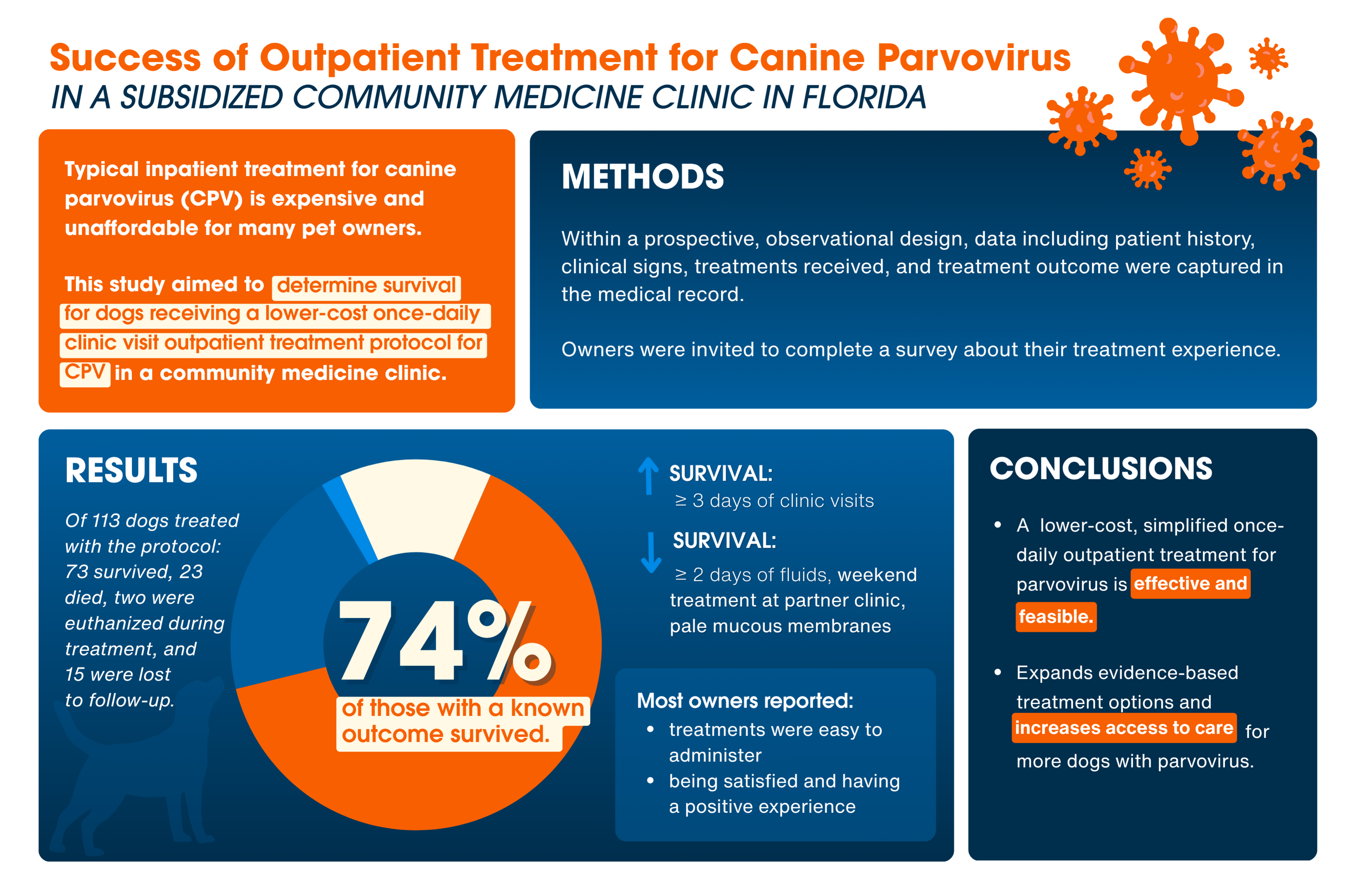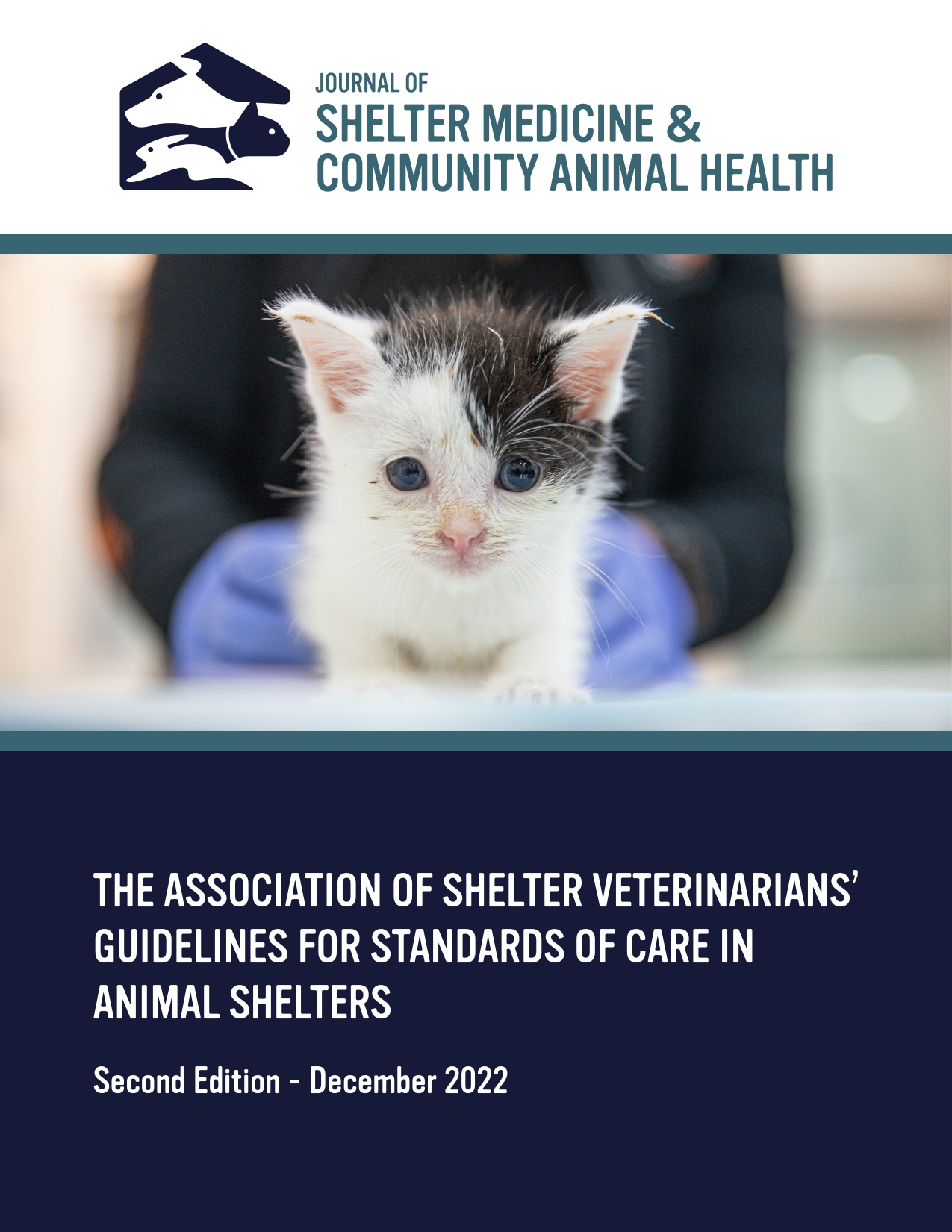Success of Outpatient Treatment for Canine Parvovirus in a Subsidized Community Medicine Clinic in Florida
DOI:
https://doi.org/10.56771/jsmcah.v4.131Keywords:
dogs, survival, access to care, lower cost, spectrum of care, client perspectiveAbstract
Introduction: Typical inpatient treatment for canine parvovirus (CPV) is expensive and unaffordable for many pet owners. Outpatient treatment may be a viable alternative when hospitalization is inaccessible due to finances or other barriers. This study aimed to determine survival for dogs receiving a once-daily clinic visit outpatient treatment protocol for CPV in a community medicine clinic. Potential predictors of survival, as well as owner-reported treatment satisfaction and feasibility, were also examined.
Methods: Within a prospective, observational design, data including patient history, clinical signs, treatments received, and treatment outcome were captured in the medical record. Owners were invited to complete a survey about their treatment experience. Survival and survey responses were summarized using counts and percentages. Logistic regression modeling was used to evaluate potential predictors of survival.
Results: During the study period of October 1, 2021, to September 30, 2023, 113 dogs met the inclusion criteria and were treated with the once-daily outpatient CPV protocol. Of these, 73 survived, 23 died, two were euthanized during treatment, and 15 were lost to follow-up. Seventy-four percent (73/98, 95% confidence interval, 65%–83%) of those with a known outcome survived. Requiring and receiving ≥ 2 days of subcutaneous fluids, having pale mucous membranes at baseline, and being referred for and receiving weekend treatment at a partner clinic predicted decreased survival, while having ≥ 3 total once-daily clinic visits was associated with increased survival. Most owners reported that the treatments were easy to administer and that they had a positive experience and were satisfied with the treatment.
Conclusion: Findings build upon existing research showing good outcomes with lower-cost CPV treatment, adding another evidence-based option to tailor treatment to the needs and preferences of the patient, client, clinic, and community. Offering outpatient treatment within a spectrum of care approach can increase access to care for more dogs with parvovirus.
Downloads
References
1.
Blackwell MJ, O’Reilly A. Access to Veterinary Care – A National Family Crisis and Case for One Health. Adv Small Anim Care. 2023;4(1):145–157. doi: 10.1016/j.yasa.2023.05.003
2.
Access to Veterinary Care Coalition. Access to Veterinary Care: Barriers, Current Practices, and Public Policy. The University of Tennessee; 2018.
3.
Njenga M, Nyaga P, Buoro I, Gathumbi P. Effectiveness of Fluids and Antibiotics as Supportive Therapy of Canine Parvovirus-2 Enteritis in Puppies. Bull Anim Health Prod Afr. 1990;38:379–389.
4.
Prittie J. Canine Parvoviral Enteritis: A Review of Diagnosis, Management, and Prevention. J Vet Emergen Crit Care. 2004;14(3):167–176. doi: 10.1111/j.1534-6935.2004.04020.x
5.
Goddard A, Leisewitz AL. Canine Parvovirus. Vet Clin North Am Small Anim Pract. 2010;40(6):1041–1053. doi: 10.1016/j.cvsm.2010.07.007
6.
Mazzaferro EM. Update on Canine Parvoviral Enteritis. Vet Clin North Am Small Anim Pract. 2020;50(6):1307–1325. doi: 10.1016/j.cvsm.2020.07.008
7.
Kelman M, Ward MP, Barrs VR, Norris JM. The Geographic Distribution and Financial Impact of Canine Parvovirus in Australia. Transbound Emerg Dis. 2019;66(1):299–311. doi: 10.1111/tbed.13022
8.
Park RM, Gruen ME, Royal K. Association between Dog Owner Demographics and Decision to Seek Veterinary Care. Vet Sci. 2021;8(1):1–19. doi: 10.3390/vetsci8010007
9.
PetSmart Charities, Gallup. State of Pet Care Study: Pet Parents’ Assessment of American Veterinary Care. 2025. Accessed May 14, 2025. https://www.gallup.com/analytics/659123/gallup-petsmart-charities.aspx
10.
King E, Mueller MK, Dowling-Guyer S, McCobb E. Financial Fragility and Demographic Factors Predict Pet Owners’ Perceptions of Access to Veterinary Care in the United States. J Am Vet Med Assoc. 2022;260(14):1–8. doi: 10.2460/javma.21.11.0486
11.
LaVallee E, Mueller MK, McCobb E. A Systematic Review of the Literature Addressing Veterinary Care for Underserved Communities. J Appl Anim Welf Sci. 2017;20(4):381–394. doi: 10.1080/10888705.2017.1337515
12.
Pasteur K, Diana A, Yatcilla JK, Barnard S, Croney CC. Access to Veterinary Care: Evaluating Working Definitions, Barriers, and Implications for Animal Welfare. Front Vet Sci. 2024;11:1335410. doi: 10.3389/fvets.2024.1335410
13.
Perley K, Burns CC, Maguire C, et al. Retrospective Evaluation of Outpatient Canine Parvovirus Treatment in a Shelter–Based Low–Cost Urban Clinic. J Vet Emergen Crit Care. 2020;30(2):202–208. doi: 10.1111/vec.12941
14.
Venn EC, Preisner K, Boscan PL, Twedt DC, Sullivan LA. Evaluation of an Outpatient Protocol in the Treatment of Canine Parvoviral Enteritis. J Vet Emergen Crit Care. 2017;27(1):52–65. doi: 10.1111/vec.12561
15.
Sarpong KJ, Lukowski JM, Knapp CG. Evaluation of Mortality Rate and Predictors of Outcome in Dogs Receiving Outpatient Treatment for Parvoviral Enteritis. J Am Vet Med Assoc. 2017;251(9):1035–1041. doi: 10.2460/javma.251.9.1035
16.
StataCorp. Stata Statistical Software: Release 17. College Station, TX: StataCorp LLC; 2021
17.
Hosmer DW, Lemeshow S, Sturdivant RX. Applied Logistic Regression. 1st ed. Wiley; 2013. doi: 10.1002/9781118548387
18.
Horecka K, Porter S, Amirian ES, Jefferson E. A Decade of Treatment of Canine Parvovirus in an Animal Shelter: A Retrospective Study. Animals. 2020;10(6):939. doi: 10.3390/ani10060939
19.
Chalifoux NV, Parker SE, Cosford KL. Prognostic Indicators at Presentation for Canine Parvoviral Enteritis: 322 Cases (2001–2018). J Vet Emergen Crit Care. 2021;31(3):402–413. doi: 10.1111/vec.13052
20.
Kalli I, Leontides LS, Mylonakis ME, Adamama-Moraitou K, Rallis T, Koutinas AF. Factors Affecting the Occurrence, Duration of Hospitalization and Final Outcome in Canine Parvovirus Infection. Res Vet Sci. 2010;89(2):174–178. doi: 10.1016/j.rvsc.2010.02.013
21.
Magalhães TR, Gregório H, Araújo J, et al. Prognostic Factors Associated with Survival and Hospitalization Time in Pediatric Canine Patients Diagnosed with Presumptive Acute Viral Gastroenteritis. Vet World. 2022;15(8):2095–2101. doi: 10.14202/vetworld.2022.2095-2101
22.
Brown CR, Edwards S, Kenney E, et al. Family Quality of Life: Pet Owners and Veterinarians Working Together to Reach the Best Outcomes. J Am Vet Med Assoc. 2023;261(8):1238–1243. doi: 10.2460/javma.23.01.0016
23.
Kogan LR, Accornero VH, Gelb E, Slater MR. Community Veterinary Medicine Programs: Pet Owners’ Perceptions and Experiences. Front Vet Sci. 2021;8:678595. doi: 10.3389/fvets.2021.678595
24.
McArthur M, Fitzgerald J. Companion Animal Veterinarians’ Use of Clinical Communication Skills. Aust Veterinary J. 2013;91(9):374–380. doi: 10.1111/avj.12083
25.
Janke N, Shaw JR, Coe JB. On-Site Communication Skills Education Increases Appointment-Specific Client Satisfaction in Four Companion Animal Practices in Texas. J Am Vet Med Assoc. 2022;260(13):1711–1720. doi: 10.2460/javma.22.06.0242
26.
Kanji N, Coe JB, Adams CL, Shaw JR. Effect of Veterinarian-Client-Patient Interactions on Client Adherence to Dentistry and Surgery Recommendations in Companion-Animal Practice. J Am Vet Med Assoc. 2012;240(4):427–436. doi: 10.2460/javma.240.4.427
27.
Stackhouse N, Chamberlain J, Bouwer A, Mexas AM. Development and Validation of a Novel Measure for the Direct Assessment of Empathy in Veterinary Students. J Vet Med Educ. 2020;47(4):452–464. doi: 10.3138/jvme.0818-096r
28.
Brown CR, Garrett LD, Gilles WK, et al. Spectrum of Care: More than Treatment Options. J Am Vet Med Assoc. 2021;259(7):712–717. doi: 10.2460/javma.259.7.712
29.
Pailler S, Slater MR, Lesnikowski SM, et al. Findings and Prognostic Indicators of Outcomes for Bitches with Pyometra Treated Surgically in a Nonspecialized Setting. J Am Vet Med Assoc. 2022;260(S2):S49–S56. doi: 10.2460/javma.20.12.0713
30.
Pailler S, Slater MR, Lesnikowski SM, et al. Findings and Prognostic Indicators of Outcomes for Queens with Pyometra Treated Surgically in a Nonspecialized Hospital Setting. J Am Vet Med Assoc. 2022;260(S2):S42–S48. doi: 10.2460/javma.20.12.0712
31.
Bryan CE, Cade JC, Mackin AJ, Sullivant AM. Evaluation of a Structured Individualised Protocol as a Potential Cost–Effective Diagnostic and Therapeutic Approach to Chronic Diarrhoea in the Dog. Vet Med Sci. 2019;5(2):210–221. doi: 10.1002/vms3.154
32.
Stull JW, Shelby JA, Bonnett BN, et al. Barriers and Next Steps to Providing a Spectrum of Effective Health Care to Companion Animals. J Am Vet Med Assoc. 2018;253(11):1386–1389. doi: 10.2460/javma.253.11.1386
33.
Elanco US Inc. Canine Parvovirus Monoclonal Antibody Product Label. 2023. Accessed Feb 10, 2025. https://assets-us-01.kc-usercontent.com/e4748d51-2c24-00f7-fc54-65f3864ee8b1/af9cbb69-e26d-4a06-b0c8-b9ec99593929/Canine%20Parvovirus%20Monoclonal%20Antibody%20PROMO_WEB_103743Asa_PA103743A_W2a%2011.20.24.pdf
34.
Larson L, Miller L, Margiasso M, et al. Early Administration of Canine Parvovirus Monoclonal Antibody Prevented Mortality after Experimental Challenge. J Am Vet Med Assoc. 2024;262(4):506–512. doi: 10.2460/javma.23.09.0541
35.
Welton M, Hadden H, Herron ME, Winston JA. Clinical Efficacy of Canine Parvovirus Monoclonal Antibody for Naturally Occurring Parvovirus in a Shelter Setting. Presented at the International Society for Companion Animal Infectious Diseases (ISCAID) Symposium; October; Vancouver; 2024.
36.
Pereira GQ, Gomes LA, Santos IS, Alfieri AF, Weese JS, Costa MC. Fecal Microbiota Transplantation in Puppies with Canine Parvovirus Infection. J Vet Intern Med. 2018;32(2):707–711. doi: 10.1111/jvim.15072
37.
IDEXX Laboratories, Inc. SNAP Parvo Test Product Insert. 2022. Accessed Jul 14, 2025. https://www.idexx.com/files/snap-parvo-pkg-insert-en.pdf

Additional Files
Published
Issue
Section
License
Copyright (c) 2025 Veronica H. Accornero, Carolyn Brown, Margaret R. Slater, Christina Hawkins, Molly Sumridge

This work is licensed under a Creative Commons Attribution 4.0 International License.









